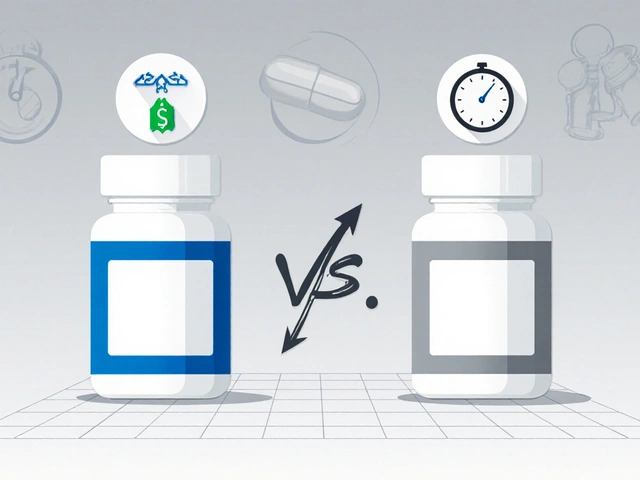
So, your doc tells you doxycycline isn’t the best fit. Maybe your skin breaks out in hives, or you get fierce stomach cramps—been there. Or maybe that bottle is just plain out of stock (again!). Good news: in 2025, you don’t have to panic because there are plenty of backup plans for treating infections—some are even better for certain conditions or age groups.
Picking an antibiotic isn’t as simple as grabbing what’s handy. Each option has its own strengths and catches—like effectiveness, allergy risks, side effects, and cost. One med might be great for lung infections but a total flop against stubborn acne. Another could have fewer stomach issues but makes you more sensitive to sunlight (hello, accidental sunburn at your kid’s soccer game!).
This article breaks down nine solid alternatives to doxycycline. If you want to chat with your doctor as an informed pro, or just want to know your options, you’re in the right place. Let’s check what’s on the table for 2025.
- Amoxicillin
- Minocycline
- Azithromycin
- Clindamycin
- Demeclocycline (Declomycin)
- Cefuroxime
- Levofloxacin
- Trimethoprim-Sulfamethoxazole (Bactrim)
- Erythromycin
- Comparison Table & Takeaway Tips
Amoxicillin
If you talk to anyone who's ever had strep throat or a persistent sinus infection, they’ve probably heard of amoxicillin. It’s been around for decades and is a go-to choice for a ton of bacterial infections. In 2025, it’s still one of the most-asked-for doxycycline alternatives—especially for people who can’t take tetracyclines (like pregnant women or young kids).
Amoxicillin works by breaking down the bacteria's cell walls, so it’s really effective for things like ear infections, throat infections, pneumonia, and even some skin infections. Plus, if you hate swallowing pills, you can get it as a chewable or liquid. Tons of parents love that when their kid’s sick and grumpy.
But it’s not perfect for everything. If you’re facing a bug that’s resistant to regular penicillin-like drugs (like some stubborn urinary tract infections), amoxicillin might let you down. Doctors check what kind of infection you have before making the swap. It also doesn’t cover as wide a range of bacteria as doxycycline does, so it’s not a universal fix.
Pros
- Safe for kids and pregnant women (unlike doxycycline, which can harm teeth or bone growth in children)
- Comes in pill, capsule, chewable, and liquid—great if you struggle with swallowing tablets
- Usually gentle on the gut; most people have fewer nausea problems
- Affordable and easy to find at almost any pharmacy
- Often covered by insurance, including generic versions
Cons
- Not effective against certain resistant bacteria, especially if you’ve used it before for similar infections
- Can trigger allergic reactions for people with penicillin allergies (sometimes severe!)
- Less effective for some conditions treated by doxycycline, like Lyme disease or certain respiratory bugs
- Might cause mild stomach upset or diarrhea
Here’s a rough idea of how amoxicillin stacks up against doxycycline for common infection types:
| Infection Type | Amoxicillin First Choice? | Alternative Needed? |
|---|---|---|
| Strep Throat | Yes | Rarely |
| Sinus Infection | Yes | Sometimes, if resistant |
| Lyme Disease | No | Yes (use doxycycline) |
| Acne | No | Yes (use doxycycline or specialty treatment) |
For most routine infections, amoxicillin is a practical, easy-to-tolerate substitute. But chat with your doctor before making any switches—they’ll consider your allergy history, recent infections, and the exact bug you’re up against.
Minocycline
If you've ever had stubborn acne or random infections that just won’t quit, chances are you’ve at least heard of minocycline. It’s part of the tetracycline family—same team as doxycycline—so it works in pretty much the same way. This drug gets right into the bacteria’s ‘machinery’ and blocks its ability to make the proteins it needs to grow and spread.
Doctors reach for minocycline when doxycycline alternatives are needed for skin issues, certain respiratory infections, or even some weird ones like tick-borne illnesses. Some folks even use it for rheumatoid arthritis. In 2025, it’s still a go-to for hard-to-treat acne when topicals just aren’t cutting it.
Quick stats? According to a study from late 2023, around 15% of acne prescriptions in teens and young adults contained minocycline, but it's also popular for tricky infections like MRSA. What's interesting is that minocycline's longer half-life means you might only need two pills a day rather than the hustle of four—handy if you're juggling pills with work, kids’ snack schedules, and all the rest.
Pros
- Often works when other tetracyclines, like doxycycline, don’t cut it
- Great for moderate to severe acne—sometimes clears skin where others fail
- Longer half-life equals fewer doses per day (only twice, usually)
- Active against some bacteria that are resistant to other antibiotics—like certain staph infections
Cons
- Higher risk of skin (and even tooth) discoloration during long-term use—think blue-gray tint, especially if you’re fair-skinned
- Can trigger dizziness or “head rush” if you stand up too fast (vertigo is a known side effect)
- Not the best for people with liver issues or those who get drug-induced lupus easily
- Can still cause GI upset or sun sensitivity, just like doxycycline—don’t forget that sunscreen at the soccer field
Minocycline’s a solid player in the antibiotic options lineup for 2025, especially when you need something similar to doxycycline, but a bit different. Still, it comes with some extra baggage, so it’s smart to check in with your doctor if you’re considering switching or if side effects show up.
Azithromycin
If you’re out to avoid doxycycline, azithromycin is one of those names you’ll hear a lot. It’s part of the macrolide family and gets prescribed all the time for a bunch of infections—everything from respiratory bugs to skin breakouts. It’s taken by mouth, usually as a quick, once-a-day dose that’s done in a few days, not weeks. Honestly, who wants to remember a pill for two weeks straight?
One cool fact: Azithromycin hangs around in your body a lot longer than most antibiotics. That’s why you can do a “Z-pack” that finishes in 3 to 5 days, and you’re still covered. Less hassle. Kids and adults both handle it pretty well, and it’s safe for folks allergic to penicillin, which can be a total lifesaver.
Pros
- Short course: Usually just 3-5 days of dosing
- Good for people with doxycycline alternatives needs, especially with penicillin allergies
- Easy on the stomach for most (compared to older macrolides)
- Great for breathing problems: bronchitis, pneumonia, sinus infections
- Safe for use in kids and pregnant women in some cases (always check with the doc!)
Cons
- Sometimes causes diarrhea or mild stomach pain
- Not so great against all skin or urinary tract infections—depends on the bug
- Can interact with some heart meds (ask if you’re already on a few prescriptions)
- Rising resistance: In some places, common bacteria are starting to laugh at azithromycin—especially for some STDs and strep throat
Doctors often reach for azithromycin when someone reacts badly to tetracyclines—or when they want to avoid long-term sunburn problems (which doxycycline is famous for). Just remember, no antibiotic works for every infection. Lab tests can help the doctor figure out if your bug will actually listen to this antibiotic, or if it’ll shrug and keep causing trouble.
Clindamycin
If you've ever needed an antibiotic when doxycycline alternatives came up, chances are clindamycin was on the short list. It's not a new kid on the block—doctors have counted on it for decades, especially when someone’s allergic to penicillin or tetracycline. Clindamycin goes after Gram-positive bacteria with a vengeance, so it shines for stuff like serious skin infections, dental abscesses, and even bone infections (osteomyelitis). For acne, it's one of the top picks if oral treatments are needed and creams just won't cut it.
This antibiotic option comes both as a pill and as a topical gel or lotion, which means you often don’t have to swallow another horse-sized tablet if your stomach can't handle it. Hospitals even keep it stocked in IV form for nasty infections that need fast action.
Pros
- Works well when allergies or resistance rule out other tetracycline substitutes like doxycycline or minocycline.
- Ideal for skin, soft tissue, and dental infections.
- Available orally, topically, and in IV form—so it's flexible.
- Often used in combination with other antibiotics for serious infections like MRSA.
Cons
- Can upset your gut; diarrhea is common, and there’s a real risk of C. difficile infection (which is pretty serious, causing severe colitis).
- Not great for treating most urinary tract or respiratory infections.
- Bacteria buildup resistance over time in certain areas—especially if you’ve used clindamycin before.
The right dose and duration really matter here, so don’t skip days even if you feel better. If you notice severe diarrhea, call your doctor—it can get ugly fast. Still, for a lot of folks needing a backup to doxycycline, clindamycin delivers dependable results. Here's a quick breakdown of what you might see in clinical use:
| Common Use | Formulation | Main Caveat |
|---|---|---|
| Serious skin/bone/dental infections | Oral/IV/Topical | Risk of gut issues, C. diff |
| MRSA infections | Oral/IV | Watch for resistance |
Demeclocycline (Declomycin)
Demeclocycline (brand name Declomycin) steps in when doxycycline alternatives are needed, especially for tetracycline substitutes. It’s part of the tetracycline antibiotic family, which means it works by blocking bacteria from making proteins, stopping them from growing or spreading. Docs usually pick demeclocycline for treating skin infections, soft tissue stuff, respiratory tract bugs, and sometimes even some unusual infections resistant to other drugs.
One interesting fact: demeclocycline isn’t just for infections. It’s also used off-label to manage low sodium in certain patients, especially if they have SIADH (Syndrome of Inappropriate Antidiuretic Hormone Secretion), though you probably won’t hear about that unless you’re hanging out with a medical professional.
Pros
- Easy to take by mouth—no need for injections.
- Solid pick for mild to moderate bacterial infections, especially skin problems.
- Works well against a broad group of bacteria.
- Sometimes used for folks who react badly to penicillin.
Cons
- Can make your skin extra sensitive to sunlight. Sunburns can happen faster, so you’ll want to cover up or grab sunscreen (imagine a sudden lobster-red face after a day outside—it’s real).
- Not prescribed as often these days, so you might have to check with different pharmacies for stock.
- Needs you to stay well hydrated—otherwise there’s a small risk of kidney problems, especially in older adults.
- Possible side effects include GI upset (nausea, diarrhea), occasionally yeast infections for some, and rarely, liver or kidney issues.
One heads-up: children under 8 and pregnant people should generally avoid demeclocycline, just like doxycycline, due to risks of teeth discoloration and effects on bone growth.
| Key Fact | Details |
|---|---|
| Taken Orally? | Yes |
| Photosensitivity Risk? | Yes, high |
| Popular Use | Skin/soft tissue infections, SIADH (off-label) |
| Not for | Kids under 8, pregnant people |
Most people handle demeclocycline just fine, but it pays to keep water handy and to look out for sun sensitivity. If you react badly to other antibiotic options or can’t tolerate doxycycline, this could be a solid backup. Just be ready to have that hydration bottle on standby—and maybe invest in some serious sunscreen.

Cefuroxime
Cefuroxime is an antibiotic you’ll spot on prescriptions for folks who can’t take doxycycline alternatives, especially if you’re dealing with common stuff like sinus infections, bronchitis, or even some stubborn urinary tract infections. It’s part of the cephalosporin family, which is different from tetracyclines and often works when the usual suspects can’t.
What’s awesome? Cefuroxime fights off a wide mix of bacteria—so if you’re not sure exactly what’s causing the infection, your doc might reach for this one while waiting on a lab result. It comes in both pill and liquid form, so it’s easier for both adults and kids, and you can take it with food to dodge nausea.
“Cefuroxime remains a reliable second-generation cephalosporin, widely used in respiratory and urinary tract infections, especially when first-line treatments aren’t an option.” — Johns Hopkins Antibiotic Guide, 2025 update
Doctors often give cefuroxime when people are allergic to penicillin or can’t handle doxycycline alternatives due to side effects. It covers a bunch of bacteria missed by other antibiotics, making it a real utility player.
Pros
- Effective against a broad range of bacteria, especially respiratory and urinary tract bugs
- Usually well-tolerated by kids and adults
- Available as oral tablets and liquid (so parents, no pill fights!)
- Can be taken with food—lowers stomach drama
- Good option if you have penicillin allergies
Cons
- Won’t help with infections caused by certain resistant bacteria
- Possible side effects: nausea, diarrhea, occasional allergic rash
- Can mess with gut bacteria, sometimes causing yeast infections
- Not the best fit for some severe infections (not as broad as some newer drugs)
| Class | Second-generation cephalosporin |
|---|---|
| Common Uses | Sinusitis, bronchitis, UTIs, mild pneumonia |
| Usual Adult Dose | 250–500 mg twice daily |
| Pediatric Use | Liquid form available, child-friendly dosing |
| Key Drawback | Bacterial resistance can develop with overuse |
Bottom line: If you’re looking for antibiotic options that hit common infections without the sunburn risk of doxy, cefuroxime is totally worth asking your doctor about.
Levofloxacin
Levofloxacin is a heavy hitter in the world of antibiotic options, especially when you face tough bacterial infections that resist basic meds like doxycycline. It’s part of the fluoroquinolone family, usually taken as a once-daily pill. Doctors often turn to levofloxacin when you’re dealing with nasty respiratory infections, certain urinary tract infections, or stubborn sinusitis. In my house, it's the 'big guns' antibiotic—one you reserve when you want to knock out something that’s not budging with regular antibiotics.
This drug covers a wide range of bacteria. Hospitals use it a lot for pneumonia, and travelers sometimes get it for gut bugs that don’t respond to typical options. However, as powerful as it is, levofloxacin isn’t a go-to without thought—most docs save it for when other meds can’t do the job.
Pros
- Broad spectrum: Works against a ton of different bacteria, so it's great if you’re unsure exactly what’s causing the infection.
- Convenient dosing: Once-daily dosing means less to remember (if you’re juggling work, kids, and two pets who think they’re royalty, this matters).
- Strong for difficult infections: It's often effective where drugs like amoxicillin or doxycycline have failed.
- Used for multiple body systems: Good for lungs, sinuses, urine, skin—and more.
Cons
- Serious side effects: Can cause tendon problems, nerve damage (peripheral neuropathy), or even mood changes in some people. This is not a medicine you take lightly.
- Can mess with the gut: Some people get diarrhea or persistent stomach upset.
- Not for everyone: Not typically used in kids, pregnant women, or people with certain heart problems.
- Possible resistance: Like many strong antibiotics, overuse means more bacteria are fighting back, making the drug less effective every year.
One thing a lot of people miss: if you’re taking iron supplements or antacids, these can block how levofloxacin works. So, you’ve got to time your doses right—at least two hours apart from those other meds. Plan ahead if you’re packing your daily pill stash for a trip or a crazy week at home.
Here's a quick look at some stats hospitals reported in 2024 about levofloxacin usage (just to give you an idea of how common it’s become as a backup):
| Condition Treated | Percentage Prescribed Levofloxacin (%) |
|---|---|
| Pneumonia (hospital-acquired) | 41 |
| UTI (complicated) | 36 |
| Sinusitis (resistant cases) | 19 |
Levofloxacin isn't for simple infections, but if you've had trouble with other bacterial infection treatment options, ask your doctor if it's on the table for you in 2025.
Trimethoprim-Sulfamethoxazole (Bactrim)
Bactrim, which mixes two antibiotics—trimethoprim and sulfamethoxazole—has been a reliable go-to in the infection world way before 2025. It’s used for a ton of problems, from urinary tract infections (UTIs) to some stubborn skin and lung infections. If you see “TMP-SMX” on your prescription, that’s this combo, and it’s often pulled out of the cupboard when someone can’t take a tetracycline like doxycycline.
Bactrim’s main claim to fame? It's pretty effective against a bunch of different bacteria, including certain bugs that regular penicillins and cephalosporins can’t touch. It’s also pretty affordable and has been generic for years, which is a win for your wallet. If you or your kid gets frequent UTIs (ask Xavier, who once needed it after a vacation swimming mishap), doctors often consider this as a reliable backup.
Bactrim works by throwing a wrench into how bacteria make folic acid, which is essential for them to multiply and survive. That double-barrel attack is what makes the combo stronger than either piece alone. But heads up: this strength means you need to follow dosing closely and let your doctor know if you have any history of kidney problems, as Bactrim is cleared that way. Too much could lead to serious side effects.
Pros
- Very reliable for UTIs, certain skin infections, and some pneumonia types, especially when other antibiotic options fail.
- Affordable (generic available almost everywhere in 2025).
- Oral and IV forms so you can use it in the hospital or at home.
- Works on several bacteria resistant to other drugs, including MRSA (methicillin-resistant Staph aureus).
Cons
- Risk of allergies—especially if you’re allergic to sulfa drugs. Watch out for skin rashes and tell your doc if you’ve reacted before.
- Can mess with kidney function in some people, especially older adults or those with kidney disease.
- Possible nausea, vomiting, and increased sun sensitivity (not too fun when you’re chasing Althea at the park in summer).
- Not effective for all types of bacteria—resistance patterns vary by region.
| Condition | Bactrim Success Rate |
|---|---|
| UTI (uncomplicated) | ~80-90% |
| Community-acquired MRSA | ~85% |
| Pneumocystis pneumonia | Widely used, high efficacy |
Bottom line: For lots of straightforward infections, especially if doxycycline alternatives are needed, Bactrim still holds its ground. But if you’ve ever had a sulfa reaction—or your kidneys aren’t in top shape—bring that up with your healthcare provider right away.
Erythromycin
So here’s the scoop on erythromycin: it’s been around forever and is one of the go-tos when someone can’t take doxycycline. Docs reach for erythromycin a lot for folks with strep throat, skin infections, and even some stomach bugs. It’s part of the macrolide family, so it works differently from tetracyclines, which helps people with allergies or gut sensitivities to other antibiotics.
Erythromycin is often used if you have an allergy to penicillin. It’s also handy for respiratory infections, a few types of pneumonia, and sometimes even for acne—especially if you’re pregnant or breastfeeding. Pediatricians still use it, but these days, newer macrolides like azithromycin are sometimes picked instead because they’re easier on the stomach.
Pros
- Well-studied: Doctors know erythromycin inside and out—it’s been on the market since the 1950s.
- Multiple forms: You can get it as tablets, liquid, and even topical gel, so it works for different needs.
- Great backup: Good for people who can’t take penicillins or tetracyclines (like doxycycline).
- Pregnancy safe: It’s one of the few antibiotics that can be used during pregnancy, if needed.
- Effective for some STIs: Erythromycin is still in use for atypical pathogens and a few older-school sexually transmitted infections.
Cons
- Tummy troubles: Erythromycin is kind of notorious for causing nausea, stomach pain, or diarrhea, especially if you skip food with your dose.
- Drug interactions: It likes to mix badly with a bunch of meds—heart drugs, statins, and even some allergy meds—so let your doc know what else you’re taking.
- Resistance risk: Some bacteria have wised up and are resistant, so it won’t always work for common infections.
- Shorter half-life: You have to take it multiple times a day, which can be a pain compared to once-a-day options like azithromycin.
- Taste: If you get the liquid version for kids, heads up—it’s bitter and not easy to hide, even in applesauce (trust me, my daughter Althea tried).
| Condition | First-line? | Benefits | Drawbacks |
|---|---|---|---|
| Strep throat | Only if allergic to penicillin | Reliable, safe for kids | Nausea risk |
| Acne | Alternative | Safe in pregnancy | Less effective than minocycline |
| Pneumonia | Sometimes, especially for atypical forms | Works when others aren’t appropriate | Resistance increasing |
Bottom line: erythromycin is a solid choice if you’re allergic to doxycycline or penicillins, need something pregnancy-friendly, or face a stubborn skin infection. But don’t expect a free ride—stomach side effects are common, and it can be a headache if you’re already on other medications.
Comparison Table & Takeaway Tips
Here’s the truth—picking the right antibiotic in 2025 isn’t just about what’s on the pharmacy shelf. It’s about matching your symptoms, your allergies, and your lifestyle with something that actually works. Below you’ll see how the doxycycline alternatives stack up next to each other. Keep in mind: even a great drug can be the wrong fit if you have the wrong bug or your body reacts badly. This is where that conversation with your healthcare provider gets real.
| Antibiotic | Main Use | Pros | Cons |
|---|---|---|---|
| Amoxicillin | Ear, sinus, throat, and urinary infections | Well-tolerated Kid-friendly Affordable |
Increasing resistance Allergy risk for some |
| Minocycline | Acne, respiratory, and skin infections | Works if doxy fails Good for acne |
Dizzy side effects Skin staining possible |
| Azithromycin | Lung, skin, sexually transmitted infections | Short course Mild side effects |
Some bugs resistant Upset stomach |
| Clindamycin | Skin, dental, bone infections | Useful for penicillin allergy Wide range |
Can cause serious diarrhea Risk of C. diff |
| Demeclocycline | Skin, soft tissue infections | Oral easy dosing | Photosensitivity Less commonly used |
| Cefuroxime | Respiratory, urinary infections | Works on tough bugs Safe in pregnancy |
More expensive Possible GI issues |
| Levofloxacin | Pneumonia, UTIs, prostatitis | Strong against many bacteria Once-daily dosing |
Tendon risks Not for kids or athletes |
| Trimethoprim-Sulfamethoxazole (Bactrim) | Urinary, respiratory, skin infections | Inexpensive Reliable efficacy |
Allergy common Not for certain chronic illnesses |
| Erythromycin | Respiratory tract infections, skin infections | Safe in pregnancy Alternative to penicillins |
Stomach upset Frequent dosing |
See what stands out? There is no perfect swap for doxycycline alternatives, but you do get solid options. A couple of tips if you’re deciding with your doctor:
- Don’t guess at infections—bacterial vs. viral needs different treatment, and antibiotics can’t touch viruses. Get a real diagnosis.
- If you’ve got allergies to penicillin, cross some meds off your list right away. Your doc will know which, but don’t hold back on sharing your full med history (yep, even that old rash from a decade ago counts).
- Side effects are real: If you need to drive carpools or face the sun all day, pay attention to warnings like dizziness or severe photosensitivity.
- Some options are better for kids or during pregnancy—your family’s needs matter. Ask if your preferred alternative is kid-safe or okay for expecting moms.
- Always, always finish your antibiotic—stopping early is how those ‘superbugs’ start appearing.
Feeling overwhelmed? You’re not alone—a bunch of us have worked through trial and error to find what actually fits. Ask questions. Listen to your body. Bring all your info to your healthcare provider and choose the best tool for the job. You’ve got choices—even if your first pick isn’t available in 2025.
11 Comments
Dhanu Sharma
July 19, 2025 AT 23:20 PM
I appreciate the rundown on multiple options besides doxycycline. It’s chill to see that there are alternatives that might suit different needs.
Sometimes, people just dislike the side effects or the taste, so having options helps.
But I wonder, what about the effectiveness? Are these alternatives as strong or do they have some trade-offs?
It would be cool to see real-world examples or user experiences to better understand.
Anyway, nice article for people looking for some choices.
virginia sancho
July 20, 2025 AT 17:30 PM
Okay so, I've prescribed doxycycline alternatives in my practice and totally agree with this guide on the importance of choice.
Each alternative works better for some infections or patient conditions, and it’s not just about allergies.
But here’s a friendly tip: always ensure the alternative antibiotic is appropriate for the infection type to avoid resistance or ineffective treatment. Don’t just swap without medical advice!
Also, some of these alternatives are better tolerated with fewer side effects, which increases patient compliance.
Overall, having options empowers patients and doctors alike.
Snehal Suhane
July 21, 2025 AT 14:13 PM
Oh great, another listicle pretending to be a comprehensive guide, right?
Doxycycline alternatives are hardly novel, but I suppose rubbing it in the user’s face that there are many options might make this post look fancy.
Are we seriously going to pretend that all these antibiotics come without their own baggage? One size doesn’t fit all, and many of these alternatives have sketchy side effects or cost a fortune.
Honestly, some of the so-called "perks" are overhyped with little clinical backing in everyday practice.
This post feels like mild fluff to me.
Eunice Suess
July 22, 2025 AT 11:00 AM
This guide is fine but honestly, I caught a few tiny spelling errors here and there which irritated me. Like, come on, it’s pretty important to spell these drug names right to avoid confusion!
Also, the lack of proper punctuation sometimes made it hard to follow the benefits versus drawbacks sections.
From a grammar geek perspective, these errors detract from the article’s professionalism and could confuse new readers.
Still, the content is solid, but editorial polish would enhance clarity tremendously.
Ernie Rogers
July 23, 2025 AT 07:53 AM
Simple truth: Americans tend to trust doxycycline more because it's proven and widely used here.
Some of these alternatives sound like things from overseas and might not have the same FDA vetting or availability stateside.
It's essential to balance new alternatives with the tried and tested, especially when you're dealing with serious infections.
Still, anyone allergic or having side effects definitely should get options, but vet your source and quality!
Just keep it practical folks.
Anoop Choradia
July 24, 2025 AT 08:53 AM
While the idea of nine alternatives is comprehensive, I can’t help but question if some of these are pushed onto the market due to pharmaceutical agendas rather than true medical necessity.
We know that big pharma has a vested interest in pushing newer drugs even when cheaper generics like doxycycline work well enough.
That said, I do recognize that allergies and patient-specific responses require alternatives; the caution is always with overarching marketing and profit motives.
It would be enlightening to have more independent research cited in a guide like this to filter fact from sponsored hype.
bhavani pitta
July 25, 2025 AT 02:56 AM
Honestly, I think people just want something different to complain about. Everyone acts like doxycycline is the devil.
Sure, side effects exist, but so do for every medicine out there.
Drama much? At least some of the alternatives might have their own ugly surprises no one wants to discuss.
Sometimes the hype around alternatives is more about the shine of novelty rather than any real benefit.
Anyway, sometimes I just think people worry too much.
Brenda Taylor
July 26, 2025 AT 05:20 AM
Ok but seriously, has anyone tried these alternatives and actually noticed a huge difference?
I mean, I'm all for choices but sometimes people just want to play doctor and pick meds without proper advice. Not cool.
Also, not to be that one person lol, but what about drug interactions with these alternatives? Always leaves me wondering.
Plus, anyone else feels like some of these alternatives get hyped but no one talks about the cost implications? Because some of these are pricey af.
Anyway, interesting guide but don’t self diagnose folks :)
Namit Kumar
August 6, 2025 AT 19:06 PM
As someone from India, I find it important that guides like this include alternatives that are easily available and affordable here.
Too often guides focus on Western markets where prices and availability differ drastically.
This creates a gap in actionable advice for many patients in Asia.
So besides clinical effectiveness, we must consider accessibility when talking about antibiotic alternatives.
Hopefully, future versions of these guides add that perspective.
:)Sam Rail
August 17, 2025 AT 08:03 AM
Good post, though I'm lazy and just gonna stick to doxycycline when doc says so.
But it's nice knowing there are alternatives if needed.
Maybe I'll read through when I have more time, this stuff gets complicated fast.
Thanks for sharing, helps to have some info laid out simply.






Edward Webb
July 18, 2025 AT 08:03 AM
This guide is genuinely helpful given the myriad of antibiotic options nowadays. Doxycycline has been a staple for so long that people often assume it's the default for all situations, but as this article points out, alternatives are often necessary due to allergies or resistance.
Exploring each alternative’s pros and cons allows patients to engage more effectively with their healthcare provider, which is critical in today's complex medical landscape. Also, it's important to remember that antibiotic stewardship is more vital than ever to prevent resistance.
However, I’d be interested in knowing how these alternatives compare in cost and accessibility internationally, as that can often be a limiting factor for many patients, especially when traveling.
In summary, this is a welcome resource that could potentially reduce adverse effects and improve treatment adherence by providing choices.